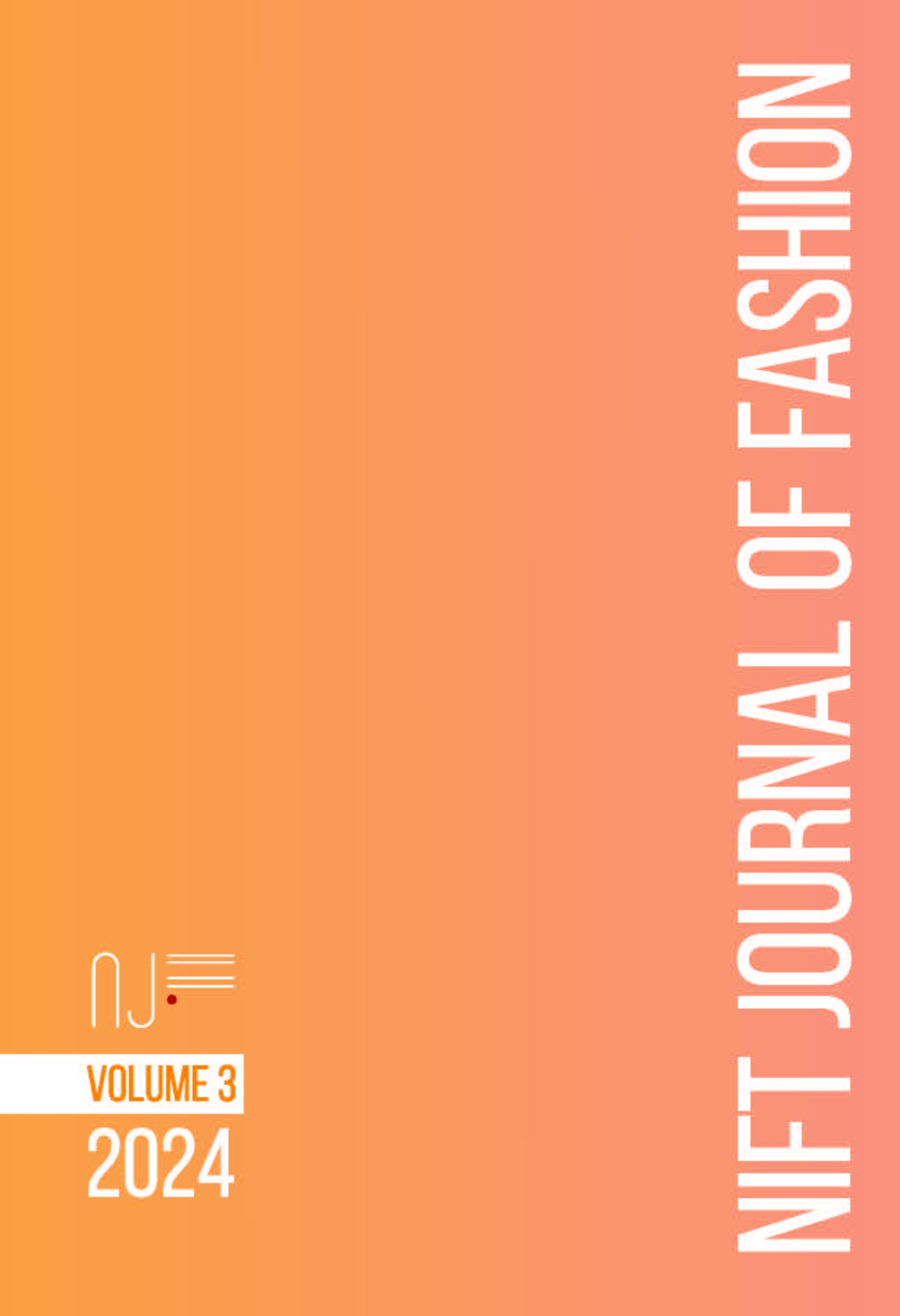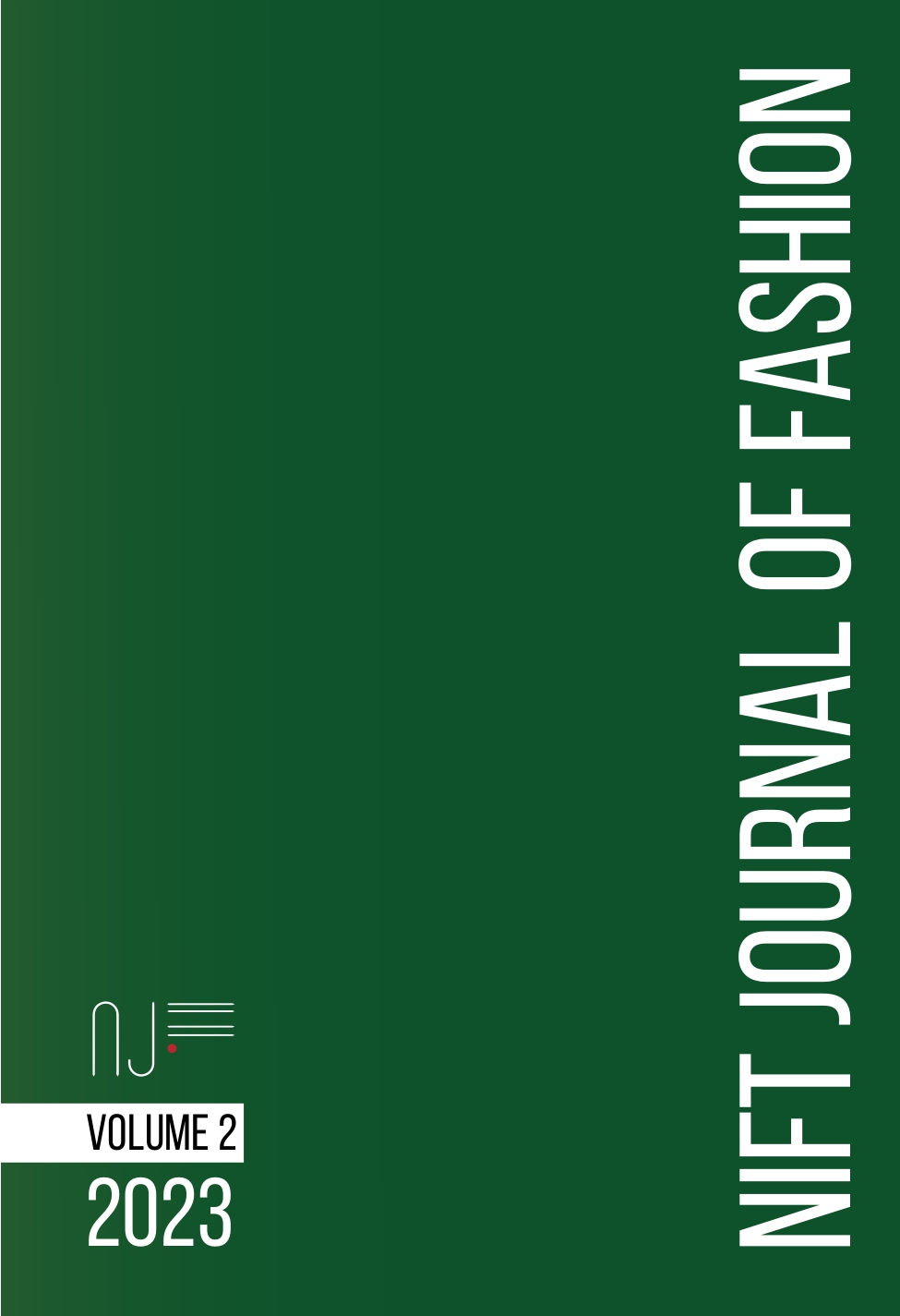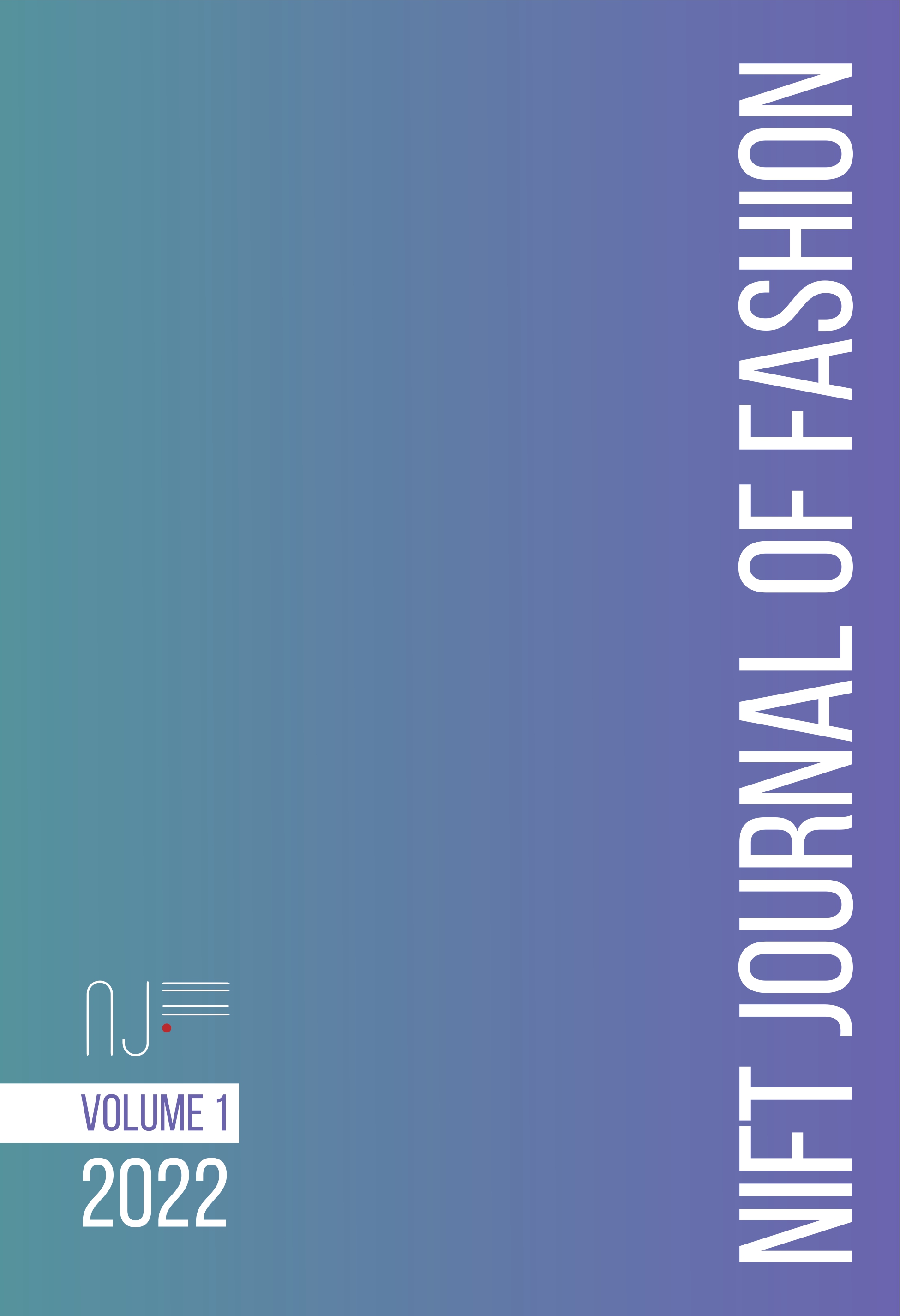Title: NIFT Journal of Fashion
Starting year: 2022
Language: English
Frequency: Annual
Version: Print (ISSN 2583-5262) and Online (e-ISSN 3048-7307)
Subject: Fashion (Design, Management, Technology)
Publisher: National Institute of Fashion Technology
Indexing:DELNET
The NIFT Publication Unit is envisaged as an in-house, interdisciplinary platform with research-centered approach to highlight the intellectual acumen of the faculty across NIFT campuses as well as scholars and educators globally. The unit brings out a scholarly publication, 'NIFT Journal of Fashion' where each annual volume has a definite theme of wide-ranging significance on different aspects of fashion with critical thinking on multiple perspectives of relevance to the wider academia and fashion industry.
Objectives
- To encourage knowledge sharing among the academia through original articles on matters of current and emerging significance, with a view to the future of fashion.
- To highlight the theory, practices and pedagogy of fashion education in the domains of design, technology and management to contribute to the fashion industry.
Mission
To encourage and disseminate quality research in the realms of fashion design, management, technology and education, sharing new knowledge, emerging trends, different perspectives and best practices that is relevant to academia and fashion professionals globally.
Scope
‘NIFT Journal of Fashion’ is a double-blind peer-reviewed and open-access journal that publishes original research articles encompassing different domains in fashion, including design, communication, management, technology and education. The journal is a thematic annual publication that invites high quality research articles from academicians, scholars and fashion professionals worldwide.
Structure
- Editor-in-Chief: The Head – Publication Unit is a senior professor who is designated as the Editor-in-Chief of the journal.
- Associate Editor: The Unit In-charge – Publication Unit is a professor who is designated as the Associate Editor of the journal.
- Advisor: Dean (Academics) is the Advisor.
- Editorial Board comprises Head – Research and all Chairpersons. Two external academicians from reputed international educational institutes and three professors from NIFT with experience and expertise in the thematic research area are co-opted for the particular volume of the journal.
Circulation and Open Access Policy
'NIFT Journal of Fashion'is a scholastic publication, circulated freely for academic purposes. It is available in both printed and online versions. The journal is published on an open access platform under the terms of the Creative Commons Attribution-ShareAlike 4.0 International License (CC BY-SA 4.0), which permits free usage, circulation, and reproduction of the content on any platform, provided the original work and source are suitably cited, and adaptations are shared under the same terms. The complete volumes of the journal are widely available free of charge on the NIFT website.
Call for Research Articles
Following the finalization of the theme, the call for research articles with requisite guidelines and time schedule is announced on the NIFT website and other official social media platforms. The announcement is widely circulated to industry and fashion institutes across the globe.
Submission of Research Articles
The research article, complete in all respects and formatted according to the author guidelines should be submitted via email at editor.njf@nift.ac.in.
Selection of Co-opted Members of the Editorial Board
Based on the nature of the theme selected for a particular volume of the journal, two external academicians from reputed international educational institutes and three professors from NIFT across campuses are invited to become members of the Editorial Board, only for that particular issue. The external and internal co-opted members are selected keeping in view their experience and expertise in the thematic research area.
Double Blind Peer Review Process
All research articles received go through the double-blind peer review process as indicated below:
- Each research article is checked for plagiarism. A maximum of 15% percent of text similarity is acceptable by the journal. If the research article exceeds the prescribed limits of plagiarism, the article is returned to the author/s.
- Following the plagiarism check, the research article is initially reviewed by the Editor-in-Chief and Associate Editor in order to assess if its topic, focus and content are according to the theme of the issue. Research articles that are not found suitable are returned to the author/s within two weeks of submission. This gives an opportunity to the author/s to rework and re-submit the research article within the prescribed submission deadlines or submit the research article elsewhere.
- Following the preliminary review, the Associate Editor in consultation with Editor-in-Chief select two suitable reviewers, who are domain experts relevant to the particular area of research. It is ensured that the identities of both the author/s and reviewers are concealed during the entire review process. Any information in the submitted research article that reveals the identity of the author/s is removed prior to the review. It is ensured that the identity of the author/s and any other personal information has been removed from the file properties of the Microsoft Word document submitted by the author/s.
- The reviewers assess the research article in terms of relevance to the theme, sound methodology of research, significant findings and conclusion, appropriate writing style, and overall recommendation.
- The reviewers are given two months’ time to submit their review reports. The scores, comments and recommendations received from the two reviewers are collated and the final recommendation (Accepted / Accepted with minor modifications / Accepted with major modifications / Rejected) along with review report are notified to the author/s. If the recommendation is ‘Accepted with modifications’, the author/s is given a month’s time to re-submit the revised research article. Following review by Editor-in-Chief, the final decision regarding the acceptance of the research article for publication is conveyed to the author/s.
Conflicts of Interest
It is the responsibility of the Editor-in-Chief and Associate Editor to carefully select the reviewers for assessment of the research article to avoid conflicts of interest. In order to maintain the ethical standards of publication, the following norms are followed.
1. In case of review of a research article submitted by in-house faculty member/s, the reviewers are always nominated from a different department and/or campus.
2. In case of review of a research article submitted by a research scholar doing doctoral studies from NIFT, it is ensured that the reviewers are neither affiliated to the NIFT Research Unit nor supervisor of the research scholar.
3. In case of review of a research article submitted by an Undergraduate/Postgraduate Bridge Programme student, it is ensured that the reviewers are neither Bridge Programme coordinators nor mentor of the student.
4. In case of review of a research article submitted by a NIFT UG/PG student, the reviewers are always nominated from a different department and/or campus. Further, the reviewer shall not be the mentor of the student.
5. In case of review of a research article submitted by an external contributor/s, it is ensured that the reviewers are not closely associated to the author/s in any way. The Editor-in-Chief and Associate Editor ensure this to the best of their knowledge.
6. In case of review of a research article submitted by Editor-in-Chief, Associate Editor or Member of Editorial Board/Advisor of the journal, the review is carried out by atleast one external reviewer and one internal reviewer, who is nominated from a different department and/or campus.
Guidelines for the Reviewers
1. Reviewers are required to sign the Confidentiality Agreement in order to ensure that the research article under review is kept strictly confidential.
2. The contents of the research article should not be disclosed, used or shared with anyone prior to its publication.
3. It is the responsibility of the reviewer to provide an honest yet respectful feedback on the research article. The objective of the review is to ascertain the quality of the research article and its suitability for publication in the theme-based journal. The review report should clearly express the strengths and weaknesses of the research article and provide constructive and unambiguous feedback that indicates to the author/s the rationale for the decision taken regarding publication.
4. The evaluation form for reviewing the research article is based on both qualitative and quantitative assessment that would assist the Editor-in-Chief to take the final decision.
Author Guidelines
- It shall be the responsibility of the author/s to ensure the following:
- The research article is an original piece of work.
- The research article has not been published elsewhere.
- The research article is not under review by another publication.
- The research presented is carried out in an ethical manner and the data and findings are not fabricated or manipulated.
- Submissions will be processed through plagiarism software to ensure the authenticity of submitted content. A maximum of 15% percent of text similarity is acceptable by the journal. If the research article exceeds the prescribed limits of plagiarism, the article will be returned to the author/s.
- The maximum number of co-authors submitting a research article is limited to three.
- The length of the research article shall be between 3500 (minimum) and 5000 (maximum) words excluding abstract, references, author/s details and biography.
- The journal accepts standard American English language.
- The author/s shall ensure that the research article is free of grammatical and typographical errors.
- The research article should be formatted in Microsoft Word, A4 size (8.27”X11.69”), portrait orientation and 1 inch margin all around.
- The text font to be used is Times New Roman, 12 point with 1.5 line spacing. The title, headings and sub-headings should be in bold font.
- The author/s should remove personal information including names from the file properties of the Microsoft Word document prior to submission.
- The research article should include the following:
- Title
- Full name of the author/s, current designation, affiliation and contact details including address, phone number and email id. If there is more than one contributing author, the corresponding author should be indicated.
- Abstract of 300-350 words with 5 to 7 keywords.
- The main body of text with suitable headings and sub-headings should include introduction, methodology, results, discussion and conclusion.
- Acknowledgement (optional)
- References should conform to the Harvard Referencing Style.
- Tables and Figures
- All tables and figures should be numbered in sequence and referred to in the text. Each table/figure should be embedded closest to the place where it has been first referred in the main text.
- Tables display data in rows and columns. The table number in Arabic numerals along with suitable caption should be positioned just above the table.
- Figures can include graph, diagram, illustration or image. The figure number in Arabic numerals along with suitable caption should be positioned just below the figure.
- Any image used should have a resolution of at least 300 dpi. All images should also be submitted separately in PNG or TIFF format.
- It is the responsibility of the author to duly acknowledge external sources and ensure that due permissions have been obtained in order to reuse any copyrighted material that has been sourced from any platform.
- The author/s should submit a short biography within 150 words along with the article.
- The corresponding author should submit duly signed Copyright Consent Form along with the submission.
- The journal does not charge any submission fee or publication fee from the author/s.
- Once the research article is accepted for publication in the journal, it cannot be withdrawn by the author/s.
- All submissions are subject to editorial review and necessary modifications.
Accurateness of Content
The information and opinions in the research articles published in the journal are solely of the concerned authors and do not necessarily represent the views of the Editors, Editorial Board, Advisors or of the Institute. The author/s are entirely responsible for the accurateness of information, data, facts, figures and opinions. The Editors or the Publisher will not accept any liability for the accuracy of any content provided by the author. However, all efforts will be made by the Editorial Team to ensure accuracy of the content to the best of their abilities.
Accurateness of Reproduction
All efforts will be made to ensure precise reproduction of the research article including the tables and figures. However, the Editors or the Publisher does not accept any liability for typographical or editorial errors, nor for any claims arising from them. The Publisher reserves the right to revise, edit and abridge the content and the accompanying material submitted for publication.
Copyright Policy and Licensing Terms
- On submission of a research article to the journal, the author/s agree to transfer the copyright of all the submitted material to the Publisher, once accepted for publication. The authors should not submit the same article, partially or wholly to another publication during the time of review, till the final decision is conveyed by the Editors.
- The journal is published on an open access platform under the terms of the Creative Commons Attribution-ShareAlike 4.0 International License (CC BY-SA 4.0), which permits free usage, circulation, and reproduction of the content on any platform, provided the original work and source are suitably cited, and adaptations are shared under the same terms.
- The authors retain the right to be identified as the author of the published article as well as the patent and trademark rights related to a product or process detailed in the article. The authors have the right to reuse the article partly or wholly for academic and commercial purposes with due acknowledgement to the journal, in accordance to the CC BY-SA 4.0 license terms.
- The authors must ensure that the research article is an original piece of work that has not been published elsewhere and is also not under review by another publication.
- The authors must guarantee that due permissions have been obtained in order to reuse any copyrighted material that has been sourced from any platform.
Downloads
NIFT Journal of Fashion, Volume 3
NIFT Journal of Fashion, Volume 2
NIFT Journal of Fashion, Volume I
NIFT Journal of Fashion © 2022 by National Institute of Fashion Technology is licensed under CC BY-SA 4.0

 Volume 3 (December 2024)
Volume 3 (December 2024) Volume 2 (December 2023)
Volume 2 (December 2023) Volume 1 (December 2022)
Volume 1 (December 2022)